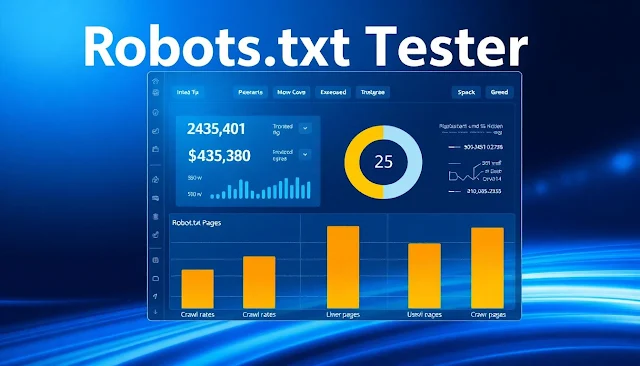Robots.txt Tester: Ensure Perfect Crawl Control for SEO Success.
Understanding Robots.txt
Let's explore what a robots.txt file is and why it matters
for your website's SEO.
What is a Robots.txt File?
This simple text file is your website's bouncer. It guides
search engine bots, like Googlebot, on what to crawl and what to skip. It's
found in your site's root.
- It lives at the top level of your domain (like,
www.example.com/robots.txt).
- It uses simple rules to allow or disallow access.
Robots.txt Syntax and Directives
The robots.txt file uses commands to control crawler
behavior. Understanding this is key for good SEO. Here are some common ones:
User-agent: This specifies which crawler the rule applies
to. Use * to target all crawlers.
Disallow: This blocks access to a specific URL or directory.
Allow: In some cases, this overrides a disallow rule. But
not all search engines respect it.
Crawl-delay: This tells crawlers how long to wait between
requests. It's not as important now.
Sitemap: This points crawlers to your XML sitemap. It helps
them find all your important pages.
Why Robots.txt is Crucial for SEO
- Control crawl budget: Direct bots to important pages, so
they don't waste time elsewhere.
- Prevent duplicate content indexing: Avoid search engines from indexing similar content.
- Prioritize key pages: Make sure your most important
content gets crawled and indexed first.
Common Robots.txt Mistakes
Making mistakes with your robots.txt file can hurt your SEO.
Accidental Disallowing of Important Pages
It's easy to block key pages by accident. This stops search
engines from seeing them.
- For example, blocking CSS or JavaScript files hurts
rendering.
- This makes it hard for search engines to properly index
your website.
Using Incorrect Syntax
Using the wrong syntax can make the whole file useless. Pay
attention to details.
- Common syntax mistakes include typos, missing colons, and
incorrect paths.
- When this happens, crawlers might ignore the file
completely or misinterpret it.
Leaving the Robots.txt File Untested
Deploying an untested file is risky. Always check your
robots.txt file before going live.
- An untested robots.txt file can lead to indexing issues.
- Regularly testing and checking it is crucial for SEO maintenance.
Case Study: Robots.txt Misconfiguration Disaster
A well-known e-commerce brand accidentally blocked its
entire website from Google’s crawlers using a misconfigured robots.txt file.
The Mistake:
They included the following directive:
User-agent: *
Disallow: /
The Impact:
- Organic traffic dropped by 85% within days.
- Product pages were removed from Google’s index.
- Sales plummeted due to the sudden disappearance of search
visibility.
The Fix:
The company quickly corrected the robots.txt file:
User-agent: *
Allow: /
Sitemap: https://example.com/sitemap.xml
Then, they used Google Search Console’s robots.txt tester to
verify the fix and requested a re-crawl.
Introducing Robots.txt Testers
Robots.txt testers are your safety net. They help you make
sure your file is doing its job right.
What is a Robots.txt Tester?
This tool checks if your robots.txt file works as expected.
It shows you if specific URLs are allowed or blocked to crawlers.
- It helps you simulate how search engine bots access your
site.
- It's a quick way to find errors before they impact your
SEO.
SEO Best Practices for Robots.txt
To maximize SEO efficiency, follow these best practices:
1. Test Before Deployment: Use Google’s robots.txt tester
before applying changes.
2. Use Specific Rules: Don’t blanket-disallow directories
unless necessary.
3. Update the File Regularly: Keep your robots.txt file
updated with changes in website structure.
4. Use Sitemap Directives: Always include your XML sitemap
in robots.txt.
5. Monitor Google Search Console: Watch for indexing issues
and fix them quickly.
Additional SEO Tips
- Use Noindex Instead of Robots.txt for Some Pages: If you
want to stop pages from appearing in search results, use the meta robots
noindex directive instead of robots.txt.
- Ensure JavaScript and CSS are Crawlable: Blocking these
files may affect how Google renders your site.
- Review Your Robots.txt with an SEO Expert: Have an SEO
professional audit your robots.txt file periodically to ensure it aligns with
best practices.



No comments:
Post a Comment